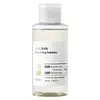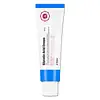What's inside
What's inside
 Key Ingredients
Key Ingredients

 Benefits
Benefits

 Concerns
Concerns

 Ingredients Side-by-side
Ingredients Side-by-side

Salix Alba Bark Water
AstringentButylene Glycol
HumectantDipropylene Glycol
HumectantGlycolic Acid 7%
BufferingTromethamine
BufferingWater
Skin ConditioningSalicylic Acid 2%
Masking1,2-Hexanediol
Skin ConditioningSodium Citrate
BufferingArginine
MaskingCaprylyl Glycol
EmollientCitric Acid 0.28%
BufferingHydroxyacetophenone
AntioxidantPentylene Glycol
Skin ConditioningAllantoin
Skin ConditioningDipotassium Glycyrrhizate
HumectantDisodium EDTA
Betula Alba Juice
AstringentWater
Skin ConditioningPropanediol
SolventTromethamine
BufferingGlycolic Acid
BufferingCetearyl Alcohol
EmollientGlycereth-26
Humectant1,2-Hexanediol
Skin ConditioningNiacinamide
SmoothingButylene Glycol
HumectantGlycerin
HumectantCyclopentasiloxane
EmollientBeeswax
Emulsion StabilisingDimethicone
EmollientPolysorbate 60
EmulsifyingCyclohexasiloxane
EmollientSorbitan Stearate
EmulsifyingPEG-240/Hdi Copolymer Bis-Decyltetradeceth-20 Ether
StabilisingGlyceryl Stearate
EmollientPanthenol
Skin ConditioningSalicylic Acid
MaskingArtemisia Princeps Leaf Extract
Skin ConditioningXanthan Gum
EmulsifyingHydroxyacetophenone
AntioxidantSodium Acrylate/Sodium Acryloyldimethyl Taurate Copolymer
Emulsion StabilisingPEG-100 Stearate
Isohexadecane
EmollientPEG-2m
Emulsion StabilisingHydrogenated Lecithin
EmulsifyingAllantoin
Skin ConditioningSucrose Distearate
EmollientPolysorbate 80
EmulsifyingAdenosine
Skin ConditioningSorbitan Oleate
EmulsifyingDisodium EDTA
Pantolactone
HumectantLactobacillus/Pumpkin Ferment Extract
Skin ConditioningPhenoxyethanol
PreservativeAnanas Sativus Fruit Extract
Skin ConditioningAlchemilla Vulgaris Extract
AstringentArnica Montana Flower Extract
MaskingActinidia Chinensis Fruit Extract
EmollientPyrus Malus Fruit Extract
Skin ConditioningGaultheria Procumbens Leaf Extract
PerfumingBetula Alba Juice, Water, Propanediol, Tromethamine, Glycolic Acid, Cetearyl Alcohol, Glycereth-26, 1,2-Hexanediol, Niacinamide, Butylene Glycol, Glycerin, Cyclopentasiloxane, Beeswax, Dimethicone, Polysorbate 60, Cyclohexasiloxane, Sorbitan Stearate, PEG-240/Hdi Copolymer Bis-Decyltetradeceth-20 Ether, Glyceryl Stearate, Panthenol, Salicylic Acid, Artemisia Princeps Leaf Extract, Xanthan Gum, Hydroxyacetophenone, Sodium Acrylate/Sodium Acryloyldimethyl Taurate Copolymer, PEG-100 Stearate, Isohexadecane, PEG-2m, Hydrogenated Lecithin, Allantoin, Sucrose Distearate, Polysorbate 80, Adenosine, Sorbitan Oleate, Disodium EDTA, Pantolactone, Lactobacillus/Pumpkin Ferment Extract, Phenoxyethanol, Ananas Sativus Fruit Extract, Alchemilla Vulgaris Extract, Arnica Montana Flower Extract, Actinidia Chinensis Fruit Extract, Pyrus Malus Fruit Extract, Gaultheria Procumbens Leaf Extract
Ingredients Explained
These ingredients are found in both products.
Ingredients higher up in an ingredient list are typically present in a larger amount.
1,2-Hexanediol is a synthetic liquid and another multi-functional powerhouse.
It is a:
- Humectant, drawing moisture into the skin
- Emollient, helping to soften skin
- Solvent, dispersing and stabilizing formulas
- Preservative booster, enhancing the antimicrobial activity of other preservatives
Allantoin is a soothing ingredient known for its protective and moisturizingg properties. Because of this, it is often added to products with strong active ingredients.
Studies show higher concentrations of this ingredient can promote wound healing.
Though it can be derived from the comfrey plant, allantoin is produced synthetically for cosmetic products to ensure purity.
Learn more about AllantoinButylene Glycol (or BG) is used within cosmetic products for a few different reasons:
Overall, Butylene Glycol is a safe and well-rounded ingredient that works well with other ingredients.
Though this ingredient works well with most skin types, some people with sensitive skin may experience a reaction such as allergic rashes, closed comedones, or itchiness.
Learn more about Butylene GlycolDisodium EDTA plays a role in making products more stable by aiding other preservatives.
It is a chelating agent, meaning it neutralizes metal ions that may be found in a product.
Disodium EDTA is a salt of edetic acid and is found to be safe in cosmetic ingredients.
Learn more about Disodium EDTAGlycolic Acid is arguably the most famous alpha hydroxy acid (AHA) with tons of research backing its benefits.
It is found naturally in sugar cane but the form used in skincare is usually synthetic for purity and stability.
Glycolic acid removes the top layer of dead skin cells to allow newer and fresher ones to emerge.
AHAs work by breaking down the structural “glue” that holds old skin cells in place. When that buildup is gone, your skin can renew itself more efficiently.
Research also shows glycolic acid stimulates collagen production, helping to firm and thicken the skin over time. This is one of its biggest advantages over other AHAs.
Overall, glycolic acid helps with:
Fun fact: Glycolic acid boosts skin hydration by helping it produce molecules that increase hyaluronic acid naturally.
To work best, glycolic acid products should have a pH between 3-4 (that’s where exfoliation is most effective but still gentle on skin).
The pH and concentration of a product are key to its effectiveness:
It is normal to feel a slight stinging sensation when using glycolic acid. This usually fades as your skin adjusts.
Because glycolic acid has the smallest molecular size in the AHA family, it can penetrate deeper, which enhances its effectiveness but also makes it more likely to irritate sensitive skin.
If your skin is very sensitive or prone to rosacea, glycolic acid may be too strong; in that case, try milder options like lactic acid or a PHA instead.
Recent studies suggest glycolic acid might even help protect against UV damage. But don’t skip sunscreen! Freshly exfoliated skin is more sensitive to the sun.
Glycolic acid is a skincare superstar. It smooths, brightens, hydrates, and firms the skin. Unless you’re highly sensitive, it’s well worth adding to your routine.
Read more about some other popular AHA's here:
Learn more about Glycolic AcidHydroxyacetophenone is antioxidant with skin conditioning and soothing properties. It also boosts the efficiency of preservatives.
This ingredient is not irritating or sensitizing.
Salicylic Acid (also known as beta hydroxy acid or BHA) is a well-known ingredient for treating skin that struggles with acne and clogged pores. It exfoliates both the skin's surface and deep within the pores to help clear out buildup, control oil, and reduce inflammation.
Unlike AHAs (alpha hydroxy acids), salicylic acid is oil-soluble. This allows it to penetrate into pores which makes it especially effective for treating blackheads and preventing future breakouts.
Salicylic acid is also known for its soothing properties. It has a similar structure to aspirin and can calm inflamed or irritated skin, making it a good option for acne-prone skin that is also sensitive.
Concentrations of 0.5-2% are recognized by the U.S. FDA as an over-the-counter topical acne product.
It can cause irritation and/or dryness if one's skin already has a compromised moisture barrier, so it's best to focus on repairing that before introducing this ingredient into your routine.
While salicylic acid does not increase sun sensitivity, it’s still important to wear sunscreen daily to protect your skin.
If you are looking for the ingredient called BHA or Butylated Hydroxyanisole, click here.
Learn more about Salicylic AcidTromethamine helps balance the pH and improve the texture of a product. It is synthetically created.
As an emulsifier, Tromethamine prevents oil and water ingredients from separating. This helps stabilize the product and elongate a product's shelf life. Tromethamine also makes a product thicker.
Tromethamine helps balance the pH level of a product. Normal pH level of skin is slightly acidic (~4.75-5.5). The acidity of our skin is maintained by our glands and skin biome. Being slightly acidic allows our skin to create an "acid mantle". This acid mantle is a thin barrier that protects our skin from bacteria and contaminants.
Oral Tromethanmine is an anti-inflammatory drug but plays the role of masking, adding fragrance, and/or balancing pH in skincare.
1,3-Propanediol, 2-amino-2-(hydroxymethyl)-
Learn more about TromethamineWater. It's the most common cosmetic ingredient of all. You'll usually see it at the top of ingredient lists, meaning that it makes up the largest part of the product.
So why is it so popular? Water most often acts as a solvent - this means that it helps dissolve other ingredients into the formulation.
You'll also recognize water as that liquid we all need to stay alive. If you see this, drink a glass of water. Stay hydrated!
Learn more about Water